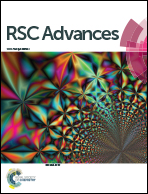Synthesis, optoelectronic and photovoltaic properties of conjugated alternating copolymers incorporating 2,1,3-benzothiadiazole or fluorenone units: a comparative study†
Abstract
A series of p-type alternating copolymers based on oligothiophene and fluorene electron-donating units, and fluorenone or benzothiadiazole electron-withdrawing units was synthesised via Suzuki coupling reaction. Their optical, electrochemical and photovoltaic properties were investigated in detail allowing rational rules to be drawn on the structure–property relationships. We highlight in this work the crucial role of the side solubilizing groups attached to the polymer backbones that have a significant impact on the morphology of the blends and the solar cell's power conversion efficiency. Devices with an active area of 0.28 cm2, based on fluorenone-copolymers and [70]PCBM blends showed Voc up to 0.95 V and Power Conversion Efficiencies (PCE) up to 1.82% under AM1.5 simulated sunlight (100 mW cm−2) conditions. These values are improved compared to the ones reported to date for this class of materials.


 Please wait while we load your content...
Please wait while we load your content...